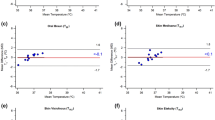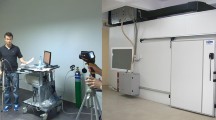Abstract
Purpose
Elevations in skin temperature and heat strain reduce tolerance to work in the heat. This study assessed agreement between mean (eight sites) and single-site skin temperature, measured by a conductive or infrared sensor, during exercise in the heat.
Methods
Twelve males (age: 24.2 ± 3.7 years; height: 180 ± 6.5 cm; body mass: 82.9 ± 9.5 kg; body fat: 16.0 ± 6.5%) volunteered to participate in two trials. Thirty minutes of seated rest was followed by 60 min of treadmill walking (4.5 km·h−1, 1%) inside an environmental chamber (35.5 ± 0.2 °C dry bulb, 50.7 ± 2.5% relative humidity) wearing either an athletic (ATH: t-shirt, shorts, shoes) or a chemical protective ensemble (CPE: ATH plus coverall and respirator). Skin temperature was measured on the axilla with a conductive sensor (Tsk-C) and an infrared sensor (Tsk-I) and compared to mean skin temperature (\({\overline{{\text{T}}}}_{{\text{sk}}},\) 8-site conductive sensors). Rectal temperature and heart rate were measured and used to calculate the adaptive physiological strain index (aPSI).
Results
Skin temperature on the chest, scapula, and thigh showed acceptable agreement with \({\overline{{\text{T}}}}_{{\text{sk}}}\) (mean difference < 0.5 °C and limits of agreement ± 1.0 °C) in both ATH and CPE. Skin temperature on the axilla overestimated \({\overline{{\text{T}}}}_{{\text{sk}}}\) in ATH (Tsk-C: 1.5 ± 0.8 °C; Tsk-I: 2.2 ± 1.2 °C) and CPE (Tsk-C: 1.1 ± 0.9 °C; Tsk-I: 1.8 ± 1.1 °C). Significant differences (p < 0.001) were observed in aPSI using Tsk-I (ATH: 5.7 ± 1.0, CPE: 8.3 ± 1.1) and Tsk-C (ATH: 5.4 ± 1.0, CPE 7.8 ± 1.0) compared to \({\overline{{\text{T}}}}_{{\text{sk}}}\) (ATH: 5.2 ± 1.0, CPE: 7.4 ± 1.0).
Conclusion
The overestimate of mean skin temperature had a significant influence on the aPSI, which has important implications for real-time monitoring and risk management of personnel working in hot environments.

Similar content being viewed by others
References
Akintola AA, Van de Pol V, Bimmel D, Maan AC, Van Heemst D (2016) Comparative analysis of the equivital EQ02 lifemonitor with Holter ambulatory ECG device for continuous measurement of ECG, heart rate, and heart rate variability: a validation study for precision and accuracy. Front Physiol
Arngrimsson SA, Stewart DJ, Borrani F, Skinner KA, Cureton KJ (2003) Relation of heart rate to percent VO2 peak during submaximal exercise in the heat. J Appl Physiol (Bethesda, Md : 1985) 94(3):1162–1168. doi:https://doi.org/10.1152/japplphysiol.00508.2002
Bach AJE, Stewart IB, Disher AE, Costello JT (2015) A comparison between conductive and infrared devices for measuring mean skin temperature at rest, during exercise in the heat, and recovery. PLoS ONE 10(2):e0117907. https://doi.org/10.1371/journal.pone.0117907
Bland JM, Altman DG (2007) Agreement between methods of measurement with multiple observations per individual. J Biopharm Stat 17(4):571–582. https://doi.org/10.1080/10543400701329422
Buller MJ, Looney D, Welles AP, Ely BR, Tharion WJ, Hoyt R (2016) An Adaptive Physiological Strain Index that Accounts for Thermal-Work Strain in High-Performance Athletes and Encapsulated Workers. Paper presented at the International Conference on the Physiology and Pharmacology of Temperature Regulation, Slovenia, Dec 2016
Buller MJ, Welles AP, Friedl KE (2018) Wearable physiological monitoring for human thermal-work strain optimization. J Appl Physiol 124(2):432–441. https://doi.org/10.1152/japplphysiol.00353.2017
Cheung SS, Sleivert GG (2004) Multiple Triggers for Hyperthermic Fatigue and Exhaustion. Exerc Sport Sci Rev 32(3):100–106
Ely BR, Cheuvront SN, Kenefick RW, Sawka MN (2010) Aerobic performance is degraded, despite modest hyperthermia, in hot environments. Med Sci Sports Exerc 42(1):135–141. https://doi.org/10.1249/MSS.0b013e3181adb9fb
Ely BR, Ely MR, Cheuvront SN, Kenefick RW, DeGroot DW, Montain SJ (2009) Evidence against a 40°C core temperature threshold for fatigue in humans. J Appl Physiol 107(5):1519–1525
Fernandes AdA et al (2014) Measuring skin temperature before, during and after exercise: a comparison of thermocouples and infrared thermography. Physiol Meas 35(2):189–203. https://doi.org/10.1088/0967-3334/35/2/189
Fernandez-Elias VE, Hamouti N, Ortega JF, Mora-Rodriguez R (2015) Hyperthermia, but not muscle water deficit, increases glycogen use during intense exercise. Scand J Med Sci Sports 25(Suppl 1):126–134. https://doi.org/10.1111/sms.12368
Gonzalez-Alonso J, Crandall CG, Johnson JM (2008) The cardiovascular challenge of exercising in the heat. J Physiol 586(1):45–53. https://doi.org/10.1113/jphysiol.2007.142158
Hunt AP, Stewart IB, Billing DC (2019) Indices of physiological strain for firefighters of the Australian Defence Forces. J Occup Environ Hygiene 16(11):727–734. https://doi.org/10.1080/15459624.2019.1666211
International Organisation for Standardisation (2004) Ergonomics: evaluation of thermal strain by physiological measurements: ISO 9886. ISO, Geneva
Johnstone JA, Ford PA, Hughes G, Watson T, Garrett AT (2012a) Bioharness(™) multivariable monitoring device: Part. I: Validity. J Sp Sci Med 11(3):400–408
Johnstone JA, Ford PA, Hughes G, Watson T, Mitchell ACS, Garrett AT (2012) Field based reliability and validity of the BioharnessTM multivariable monitoring device. J Sports Sci Med 11(4):643–652
Kim JH, Roberge R, Powell JB, Shafer AB, Jon Williams W (2013) Measurement accuracy of heart rate and respiratory rate during graded exercise and sustained exercise in the heat using the Zephyr BioHarness. Int J Sports Med 34(6):497–501. https://doi.org/10.1055/s-0032-1327661
Liu Y, Zhu SH, Wang GH, Ye F, Li PZ (2013) Validity and reliability of multiparameter physiological measurements recorded by the equivital lifemonitor during activities of various intensities. J Occup Environ Hygiene 10(2):78–85. https://doi.org/10.1080/15459624.2012.747404
Maley MJ, Costello JT, Borg DN, Bach AJE, Hunt AP, Stewart IB (2017) An overt chemical protective garment reduces thermal strain compared with a covert garment in warm-wet but not hot-dry environments. Front Physiol 8:913. https://doi.org/10.3389/fphys.2017.00913
Maley MJ, Hunt AP, Bach AJE, Eglin CM, Costello JT (2020) Infrared cameras overestimate skin temperature during rewarming from cold exposure. J Therm Biol 91:102614. https://doi.org/10.1016/j.jtherbio.2020.102614
Moran DS, Shitzer A, Pandolf KB (1998) A physiological strain index to evaluate heat stress. Am J Physiol Regul Integr Comp Physiol 275:R129–R134
Olesen BW (1984) How many sites are necessary to estimate a mean skin temperature? Thermal Physiology. Raven Press, New York, pp 33–38
Ramanathan NL (1964) A new weighting system for mean surface temperature of the human body. J Appl Physiol 19(3):531–533
Sawka MN, Leon LR, Montain SJ, Sonna LA (2011) Integrated physiological mechanisms of exercise performance, adaptation, and maladaptation to heat stress. Comprehensive Physiol 1:1883–1928. https://doi.org/10.1002/cphy.c100082
Tharion WJ, Buller MJ, Potter AW, Karis AJ, Goetz V, Hoyt RW (2013) Acceptability and usability of an ambulatory health monitoring system for use by military personnel. IIE Trans Occup Ergon Hum Fact 1(4):203–214. https://doi.org/10.1080/21577323.2013.838195
Funding
No funding was received for this study.
Author information
Authors and Affiliations
Contributions
AH and IS contributed to the conception and design of the study. BM, KM, and AH contributed to the acquisition, analysis, and interpretation of data. BM and AH were responsible for drafting the manuscript, and all authors were engaged in revising it critically for important intellectual content. All authors approved the final version of the manuscript and agreed to be accountable for all aspects of the work in ensuring that questions related to the accuracy or integrity of any part of the work are appropriately investigated and resolved. All persons designated as authors qualify for authorship, and all those who qualify for authorship are listed.
Corresponding author
Ethics declarations
Conflict of interest
The authors declare that the research was conducted in the absence of any commercial or financial relationships that could be construed as a potential conflict of interest.
Additional information
Publisher's Note
Springer Nature remains neutral with regard to jurisdictional claims in published maps and institutional affiliations.
Rights and permissions
About this article
Cite this article
MacLean, B.L., MacLean, K., Stewart, I.B. et al. Monitoring heat strain: the effect of sensor type and location on single-site and mean skin temperature during work in the heat. Int Arch Occup Environ Health 94, 539–546 (2021). https://doi.org/10.1007/s00420-020-01600-y
Received:
Accepted:
Published:
Issue Date:
DOI: https://doi.org/10.1007/s00420-020-01600-y




